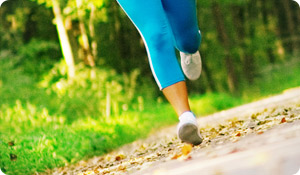
The number of people taking up running in the US is on the rise. With that, the number of running injuries is rising as well. While running is no doubt beneficial for overall health, injuries are common, and in a recent study, researchers found that running shoes may actually put more of a strain on your joints than if you were to run barefoot or even to walk in high-heeled shoes.
The study, published in the December 2009 issue of American Academy of Physical Medicine and Rehabilitation, found that high-tech running shoes, due to their elevated heel, put pressure on an area of the knee where osteoarthritis (the breakdown of cartilage) typically develops. Furthermore, the researchers found that running shoes cause increased joint torques at the hips, knees and ankles.
The study participants included 37 women and 31 men who typically wore running shoes and ran recreationally, at least 15 miles (24 km) per week. The subjects were then studied in a "gait laboratory," running either barefoot or with a typical running shoe on a treadmill that contained what the researchers called a "forceplate." The forceplate provided measurements of the magnitude of the participants' bodyweight forces on their joints, and the direction of those forces.
The subjects also had markers on their knees, hips and ankle joints, and as they ran, cameras photographed the markers, allowing the researchers to see how the joints moved.
D. Casey Kerrigan, MD, lead author of the study, said that when the participants were wearing running shoes, the researchers saw a 38 percent increase in torque in areas of the knee where osteoarthritis develops. Such a large increase was surprising, she said, because it was greater than the increase in knee torque she had observed for women wearing high heels, which was only 20 percent to 26 percent.
Should You Get Rid of Your Running Shoes?
"I don't think this study should promote running barefoot," said D. Casey Kerrigan, MD. "I think people should run in what they feel most comfortable running in ... and whether that's in a pair of running shoes or in a minimum kind of running shoe, that's just fine."
Running barefoot, however, has become somewhat trendy lately due to the best-selling book Born to Run by Christopher McDougall. In the book, McDougall, an avid runner who had been vexed by injuries, argues that barefoot running is better for you than wearing high-tech running shoes. He makes the case that high-tech shows have led to poor running form--the culprit of running injuries.
Another study, conducted by Daniel E. Lieberman, a professor of human evolutionary biology at Harvard University, and published in the journal Nature, concurs with this argument. Lieberman and his researchers recorded the running and strike style of three groups of runners: people who had always run barefoot, people who had always run with shoes, and people who had switched from shoe to shoeless.
The study showed that barefoot runners tend to hit the ground toe first (a style they found minimizes forces that jar the body), while people used to running shoes have largely adopted a heel-first style (found to cause a lot of force on the body).
Despite the recent studies and growing movement of barefoot runners, many researchers are calling for more evaluation before you abandon your sneakers.
In the meanwhile, here are some tips to prevent running injuries.
Tips to Prevent Joint Strain and Running Injuries
- Run upright—with your head over your shoulders, your shoulders over your hips, and your hips over your knees.
- Take brief walk breaks to allow your body to recover. Try running 8 minutes and walking for 1 minute. Repeat this pattern throughout your run.
- Run on a variety of surfaces to avoid repetitive joint strain.
- If you are training for a marathon, train slowly over a long period of time.
- You may want to try simpler shoes with less cushioning if you are a major heel-striker.
Sources:
Fredericson, M. Epidemiology and Aetiology of Marathon Running Injuries. Sports.Medicine. http://cat.inist.fr/?aModele=afficheN&cpsidt=18800273. Accessed January 31, 2010.
Harmon, K. Observations: Running Barefoot is Better, Researchers Find. Scientific American. http://www.scientificamerican.com/blog/post.cfm?id=running-barefoot-is-better-research-2010-01-27. Accessed January 31, 2010.
Kerrigan, D.C. Franz, J.L. et al. The Effect of Running Shoes on Lower Extremity Joint Torques. PM&R, Volume 1, Issue 12, December 2009, Pages 1058-1063. http://www.sciencedirect.com/science?_ob=ArticleURL&_udi=B8JHF-4XX36D1-2&_user=10&_rdoc=1&_fmt=&_orig=search&_sort=d&_docanchor=&view=c&_acct=C000050221&_version=1&_urlVersion=0&_userid=10&md5=0bea7b09825dec6d17d30e7ec502b545. Accessed January 29, 2010.
Parker-Pope, T. The Human Body is Built for Distance. New York Times. http://www.nytimes.com/2009/10/27/health/27well.html?_r=1. Accessed January 31, 2010.
Rettner, R. Running Shoes Changed How Humans Run. LiveScience. http://www.livescience.com/animals/running-shoes-barefoot-running-100127.html. Accessed January 29, 2010.
Rettner, R. Study: Running Shoes Could Cause Joint Strain. Yahoo News. http://news.yahoo.com/s/livescience/20100112/sc_livescience/studyrunningshoescouldcausejointstrain. Accessed January 29, 2010.





